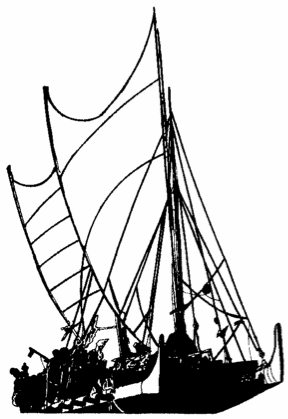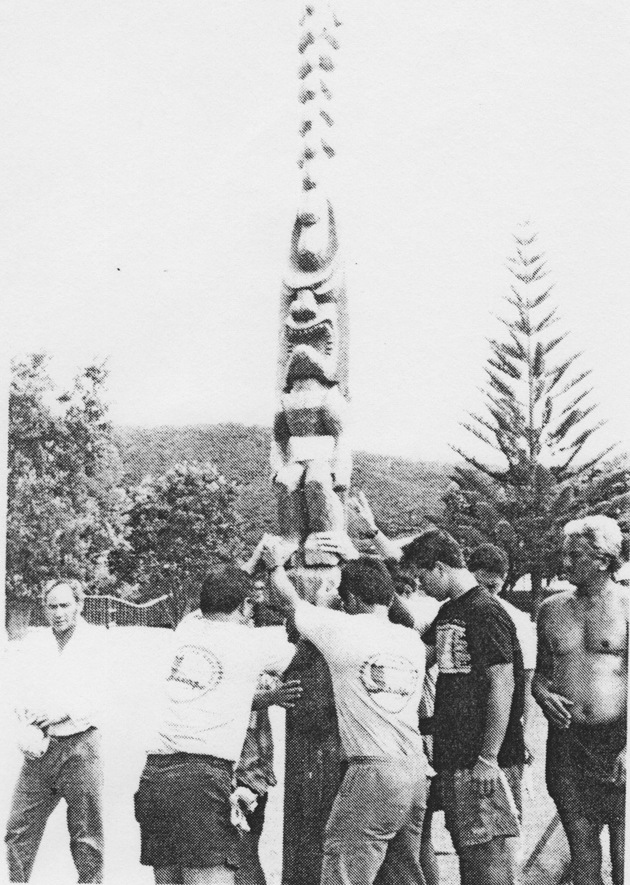PVS Newsletter / March, 1992
Hokule‘a has been on dry dock at Pier 40 for the past three months being prepared for her next Pacific voyage. To celebrate the efforts of this joint venture with the Hawaii Maritime Center, PVS will hold its ANNUAL MEMBERSHIP MEETING, Wednesday, April 1, 1992 5:30 p.m., at Pier 40, Honolulu Harbor.
The program will include reports on PVS' projects, elections, a short video of our ki'i presentation at Waitangi, New Zealand and a musical treat by our Maori connection from Kamehameha Schools.
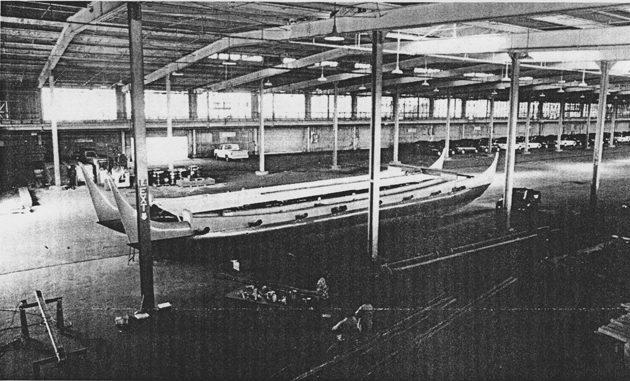
January 31, 1992 Pier 40, Honolulu Hokule‘a being refurbished. Photo by Monte Costa
As a result of the profound impression our voyaging canoe Hokule‘a has made throughout the Pacific, the vessel has been invited to take part in the 6th annual Pacific Festival of Arts, celebrating the "Voyaging Peoples of the Pacific," to be held in Rarotonga in the Cook Islands during October, 1992. This will be another major voyage for the canoe.
After a thorough going-over to put her in tip-top shape, Hokule'a will sail to South Point (the southernmost tip of the Island of Hawai'i) then on to Tahiti, Leaving Tahiti, she will visit Huahine and Raiatea. At Raiatea, navigator Nainoa and the eighteen navigators from around the Pacific who he has trained will be honored at Taputapuatea Marae (an ancient temple) in rites blessing their voyage. It will be the first time in 700 years that such rites have been carried out at this marae. From Raiatea 11-olCu- le'a will proceed to Rarotonga where she will be joining voyaging canoes from Majuro Atoll, Samoa, Tonga, New Zealand and other islands of the Cook Group.
TWO MAJOR CANOE PROJECTS
Society members are well into Phase One of the Native Hawaiian Culture and Arts Program which involves the construction of two newcanoes and the training of crews in preparation for a historic voyage from the Marquesas Islands to Hawai'i in 1994.
The new canoe project will build on the expertise gained from the experiences of Hokule‘a, whose voyages were scientific and cultural, providing a foundation for deeper understanding of voyaging traditions.
The first new canoe, "Hawai'iloa," now under construction on the Bishop Museum grounds, is also a voyaging canoe (wa'a kaulua ). It is traditional in design and materials--a significant step beyond Hokule‘a. However, because of its size, traditional tools and methods cannot be used. Construction of a large canoe in ancient time required the skills of many canoe builders; skills which are all but lost today.
July 13, 1991, Halau Wa'a, Bishop Museum: Harold Ayat Shaping the sides of one hull (by smoothing out the planes).
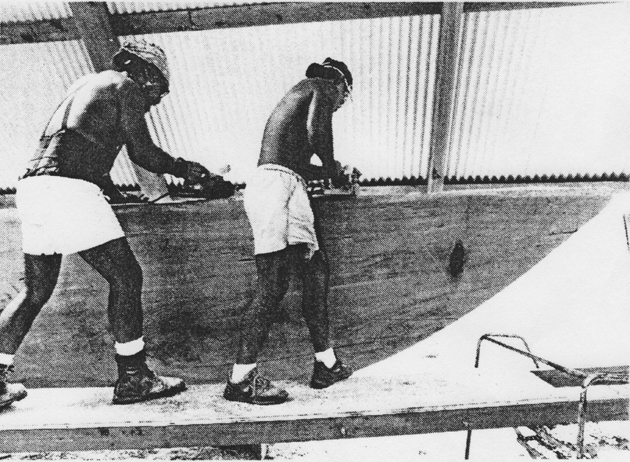
September 7, 1991 Rocky Jensen (left) & Harold Ayat (right) work on squaring away the top of the hull.
The Wa'a Kaukahi
The search to find a log for the hull of the smaller coastal canoe ended when a suitable tree was found in the Keauhou Forest on the island of Hawai'i.
On Saturday, February 29 Society members and others gathered on the slopes of Mauna Loa to plant 3,000 koa seedlings to give back to the land before taking a tree.
The planting accomplished, they gathered at the chosen tree for the ceremonies so important to beginning the construction of a new canoe: Kelii Taua chanted the blessing and with great humility asked the tree its permission to be used for the noble purpose of building a canoe in order that during its construction and sailinh life, Hawaiian youth could be trained and educated in the appreciation of their rich seafaring heritage; that the canoe would add further impetus to the renaissance of interest in Hawai'l's cultural past.
In order to emulate ancient methods to the greatest degree possible, this canoe will be built entirely of materials found in Hawai'l, and only traditional tools and construction methods will be used, in the hope of regaining lost knowledge and skills.
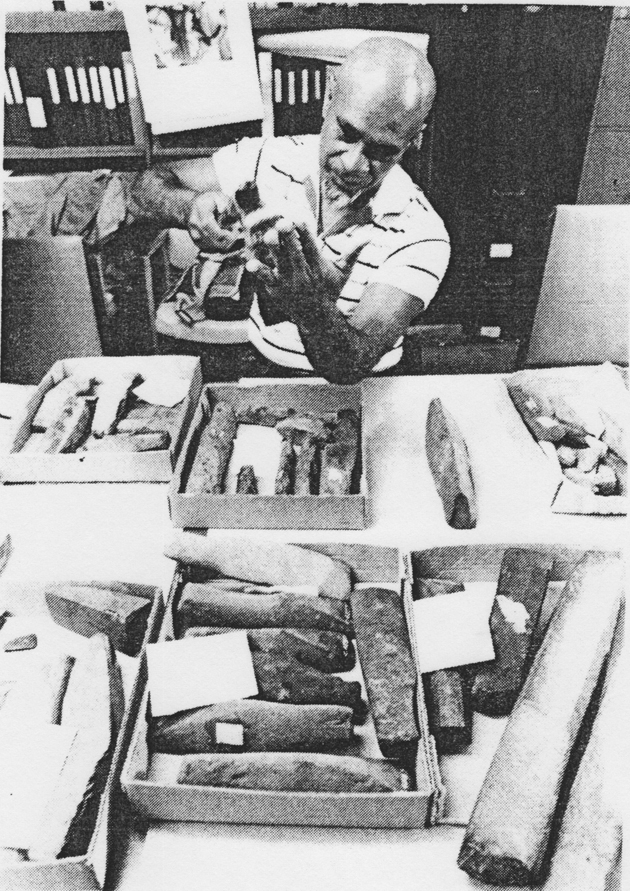
December 20,1991 Office of Dr. Yos ihiko Sinoto. Bishop Museum Anthropology Dept. Tava Taupu examines (stone adz) arfifacts to better understand ttadibonal tools and how they were created. Tava has constructed handles and has shaped the adz stones which will be used to fell the tree and construct the new canoe. Photo by Monte Costa
A MAJOR FILM
"In the Wake of Our Ancestors," produced by former crew member Gail Evenari, is a half-hour film that takes viewers through the first stages of the Hawai'iloa project, including the search for koa logs in Hawai'l, the dramatic tree-felling ceremony in southeast Alaska, the arrival of the logs at the Bishop Museum and the shaping and carving of the canoe hulls.
The story takes a unique turn when the focus shifts to the concerns raised by the failure to find suitable koa logs and a strong commitment is made to care for the natural environment of Hawai'l.
We're hoping that the film will premiere in Honolulu in the late spring. It is scheduled to be shown on Public television in the fall of 1992.
A MAJOR BOOK
NZ's Massey University hasjust published From Sea to Space written by Ben Finney, Society's founding president. It is the printed version of three Macmillan Brown Memorial Lectures that Ben presented at Massey: "Voyaging into Polynesian's Past," summarizes the entire Hokule‘a project. Chapter Two deals with the impact of France's Nuclear testing program on the people of French Polynesia. Chapter Three considers human prospects in space, and makes the point that from the exploration and settlement of Polynesia to the exploration and settlement of space is a natural progression.
The book is being distributed in Hawai'i by the University of Hawai'i Press and costs $10.95. Special discount order forms will be mailed to PVS members.
THE POLYNESIAN CONNECTION
For hundreds of years there was no communication between the Maori of New Zealand and the Hawaiians far to the north, separated as they were by thousands of miles of ocean. Judging from reports they had been hearing in more recent times, the Maori, like other Polynesians, had long since written the Hawaiians off as a people who had lost theirculture and who nolonger
looked with pride on their heritage; a people completely subjugated by an alien culture. Then, in December, 1985, Hokule‘a sailed into New Zealand's Bay of Islands on her Voyage of Rediscovery, retracing the routes of settlement used by the ancestors of all Polynesians.
Although well aware of the projected voyage and its scientific aspects, the Maori were unprepared to see a crew made up mostly of Hawaiians. Their astonishment quickly turned to rejoicing in the spirit of family, for here were some of the lost, reappearing as if by magic, and they had arrived in a voyaging canoe that looked like those sailed by the first Maori settlers so many centuries earlier! After deliberating the idea of kinship, the Maori concluded that these adventurous seafarers ought to be acknowledged as true kin by being accepted as their sixth ttibe. And so it was arranged.
In January of 1992, the acknowledgement was forrnally consummated when a contingent of Society members and persons from the Kamehameha Schools traveled to New Zealand as representatives to receive the honor, to present to their Maori "cousins" a 9-foot tiki created from ‘ohia wood by Bill Puou of Kona.
On January 5th, members of the Tai Tokerau tribe welcomed them with traditional chanting, singing and speeches. Kamehameha students responded with pules, chants, songs and dances; others of the delegation expressed the gratitude of all. Our tiki was presented and named MAUI-PA-MAMAO (Maul-who-touches-the-farthest-extremities), which refers to the existence of Maul in virtually every Polynesian culture.
